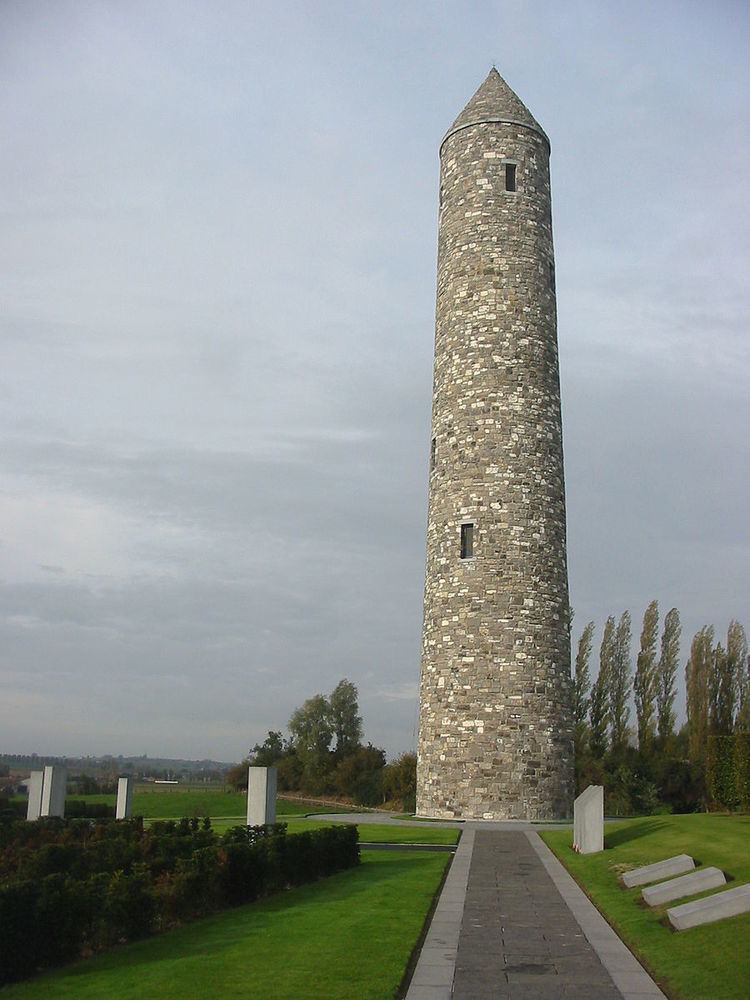 | ||
Unveiled 11 November 1998 (1998-11-11) Similar Spanbroekmolenkrater, Saint Julien Memorial, Croonaert Wood, Yorkshire Trench and Dug Out, Ulster Tower | ||
The island of ireland peace park
The Island of Ireland Peace Park and its surrounding park (Irish: Páirc Síochána d'Oileán na hÉireann), also called the Irish Peace Park or Irish Peace Tower in Messines, near Ypres in Flanders, Belgium, is a war memorial to the soldiers of the island of Ireland who died, were wounded or are missing from World War I, during Ireland's involvement in the conflict. The tower memorial is close to the site of the June 1917 battle for the Messines Ridge.
Contents
- The island of ireland peace park
- Island of ireland peace park mesen belgium
- Development
- Design
- Unveiling
- Peace Pledge
- The park
- Messines Peace Village
- References
Island of ireland peace park mesen belgium
Development
Because of the events of the Easter Rebellion in 1916 and the partition of Ireland under the Anglo-Irish Treaty in 1922 and the Irish Civil War that followed it, little was done in the Republic of Ireland to commemorate the Irish dead from the Great War or World War II. Those countries who were engaged in the Great War all preserve the memory of their fallen soldiers with national monuments in the Western Front area. This led to some ill-feeling in the already crowded emotions of the conflict on the island, and perhaps was highlighted when Northern Ireland's community's Ulster Tower Thiepval in France was one of the first memorials erected.
This Tower memorial, however, serves not to "redress the balance" but rather to recall the sacrifices of those from the island of Ireland from all political and religious traditions who fought and died in the war. It also serves as a symbol of modern-day reconciliation. The Tower houses bronze cubicles containing record books listing the known dead, which are publicly accessible copies of the originals belonging to the National War Memorial, Islandbridge, Dublin.
The project was initiated by A Journey of Reconciliation Trust, a broad-based cross-border Irish organisation which hopes to bring together people of diverse beliefs. The Trust comprises representatives of the main churches in Ireland and professional political and representatives and community leaders from both parts of Ireland under the leadership of Paddy Harte and Glenn Barr.
The building of the tower was marked by conflict over who would pay what towards the costs of construction. Construction costs were finally met by contributions from the British and Irish governments and from commercial sponsors but some problems with drainage, tree growth and surfacing in the park around the tower existed for the first few years. The park was subsequently restructured to its present design under the auspices of the Dublin City Council in 2004.
Design
The 110-foot (34 m) tower is in the traditional design of an Irish round tower and is partially built with stone from a former British Army barracks in Tipperary, the remainder of the stone from a work-house outside Mullingar, County Westmeath.
The design has a unique aspect that allows the sun to light the interior only on the 11th hour of the 11th day of the 11th month, the anniversary of the armistice that ended the war and the time for the minute's silence on Remembrance Day.
A commemorative ceremony is held yearly in the park on that date, in conjunction with similar ceremonies at the nearby multi-national Menin Gate Memorial in Ypres.
Unveiling
The tower was unveiled after an 11 am service on 11 November 1998 by President Mary McAleese of Ireland, Queen Elizabeth II of the United Kingdom and King Albert II of Belgium.
In her speech, President McAleese said:
Speaking at the official re-opening of the newly structured park on 7 June 2004, the Irish Minister for Foreign Affairs Dermot Ahern commented that honouring the spirit of all Irish people killed in the First World War can teach how to advance the Northern Ireland peace process, adding:
Peace Pledge
A bronze tablet on a granite pillar positioned in the centre circle of the park bears the following inscription, entitled:
The park
Messines Peace Village
The completion of the Peace Park ultimately led to the development and construction of the Messines Peace Village, an international rural hostel equipped for seminars and meetings, ideal for associations, companies, youth and school groups.
The first stone was placed on 7 June 2005 by Taoiseach na hÉireann (Prime Minister of Ireland) Bertie Ahern in the presence of the Mayor of Messines, Sandy Evrard and the Flemish Minister of Administrative Affairs, Foreign Policy, Media and Tourism, Geert Bourgeois.
Only one year later, the Peace Village was officially opened. The inauguration took place on 7 June 2006 by the Irish Minister of Foreign Affairs, Dermot Ahern, the British Minister for Northern Ireland, David Hanson, the Flemish Minister of Administrative Affairs, Foreign Policy, Media and Tourism, Geert Bourgeois and Sandy Evrard, the Mayor of Messines.
